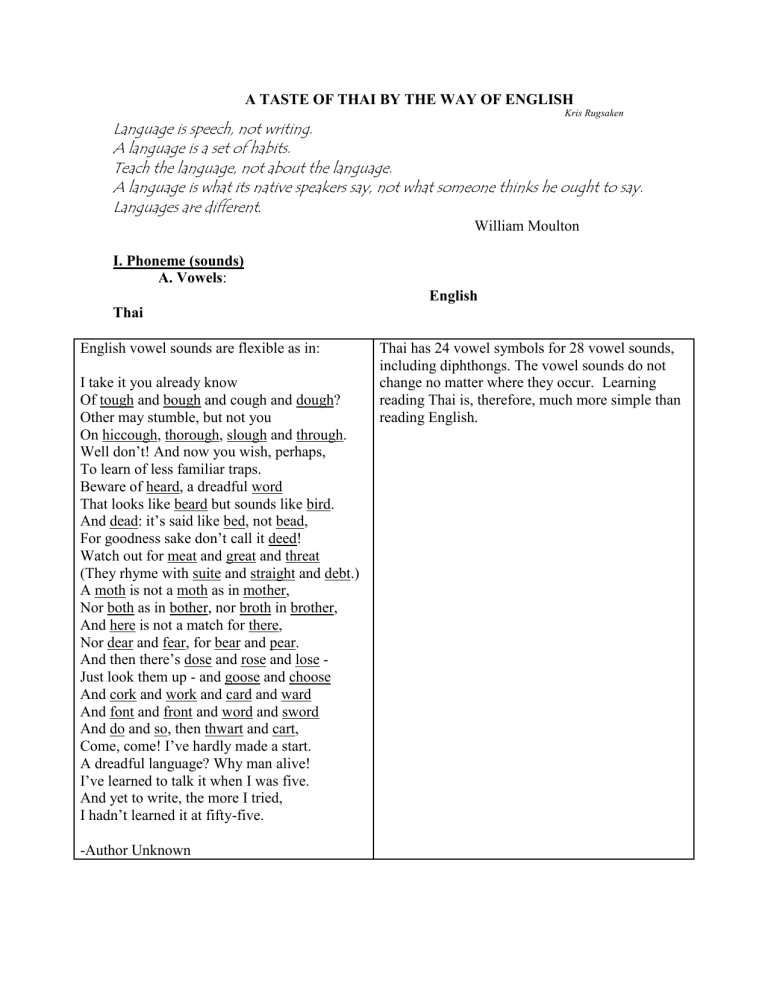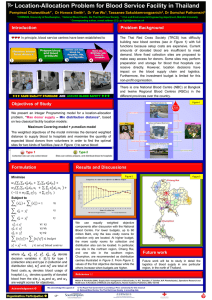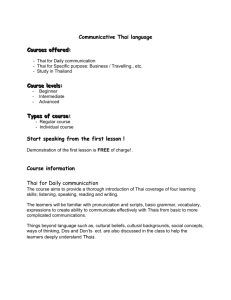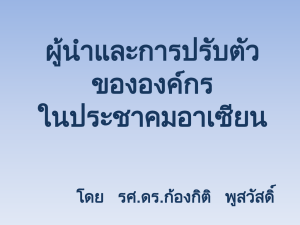A TASTE OF THAI BY THE WAY OF ENGLISH
advertisement

A TASTE OF THAI BY THE WAY OF ENGLISH Kris Rugsaken Language is speech, not writing. A language is a set of habits. Teach the language, not about the language. A language is what its native speakers say, not what someone thinks he ought to say. Languages are different. William Moulton I. Phoneme (sounds) A. Vowels: English Thai English vowel sounds are flexible as in: I take it you already know Of tough and bough and cough and dough? Other may stumble, but not you On hiccough, thorough, slough and through. Well don’t! And now you wish, perhaps, To learn of less familiar traps. Beware of heard, a dreadful word That looks like beard but sounds like bird. And dead: it’s said like bed, not bead, For goodness sake don’t call it deed! Watch out for meat and great and threat (They rhyme with suite and straight and debt.) A moth is not a moth as in mother, Nor both as in bother, nor broth in brother, And here is not a match for there, Nor dear and fear, for bear and pear. And then there’s dose and rose and lose Just look them up - and goose and choose And cork and work and card and ward And font and front and word and sword And do and so, then thwart and cart, Come, come! I’ve hardly made a start. A dreadful language? Why man alive! I’ve learned to talk it when I was five. And yet to write, the more I tried, I hadn’t learned it at fifty-five. -Author Unknown Thai has 24 vowel symbols for 28 vowel sounds, including diphthongs. The vowel sounds do not change no matter where they occur. Learning reading Thai is, therefore, much more simple than reading English. B. Consonants: English Thai 1) The following English consonant sounds do not occur in Thai: /g/ (as in) go, gate, game, rug, big /O/ (as in) think, thin, bath, both // (as in) that, they, breathe /v/ (as in) van, vent, vine /z/ (as in) zip, zinc, zero /z/ (as in) garage, pleasure /r/ (as in) rug, railroad, raw 1) Thai students substitute it with the following sound: /k/ /t/ or /s/ /d/ /f/ or /w/ /s/ /s/ /l/ or /rr/ 2) All English consonant sounds occur in the final position of the syllable. 2) Only eight consonant sounds occur in the final position of the syllable: /k/, /d/, /p/, /n/(ng), /n/, /m/, /y/, /w/. Therefore, Thai students may substitute the following sounds: /n/ for /l/ in “bill” and “table” /p/ for /f/ in “tough” and “Jeff” /d/ for /s/ in “class” and “miss” /h/ for /r/ in “car” and “dear” /t/ for /O/ as in “both” and “soothe” A cluster of consonant sounds is even a greater problem for the Thai, i.e. film, films, disk, disks, cast, lands. 3) Many English symbols share the same sounds: /s/ pass, place, seat, ceiling /z/ use, zip /f/ photo, film, rough, ruff /k/ cat, kid, rake, pack 3) Only one- when /t/ and /r/ are together, they sound like /s/ 4) Some English consonants represent more than one sound: c = cat, call, cinema, cell s = see, said, sugar, sure g = gage, garage, giant, geography ch = church, chat, choir, chemistry 4) No sir, there’s nothing like that. Thai consonants are monophonic. C. Intonation: English Thai English intonation is inconsistent to the Thais. Examples: CanadaCanadian IndianaIndianapolis Europe European Psychology Psychological Thai is a tonal language and the tones, which mark the meaning of words, never change. II. Morphemes (word formation) A. Singularity/Plurality English Thai dog -> dogs bus -> buses man -> men child -> children mouse -> mice louse -> lice fish -> fish deer -> deer (Subject/verb agreement- must agree ) dog -> many dog/ bus -> many bus man -> many man/child -> many child mouse -> many mouse fish -> many fish (Always agree-never conflict) B. Tenses English Thai present go come eat bring past went came ate brought past perfect gone come eaten brought Inflexible verb forms go go+adv-t(ime) already go come come+adv-t already come eat eat+adv-t already eat bring bring+adv-t already bring C. Affixes (Prefix/Infix/Suffix) English Thai Prefix: correct -> incorrect honest -> dishonest Infix: nation -> national -> nationalize interest -> interesting -> interestingly Suffix: man -> manly flame -> flammable For the most parts, Thai is a monosyllabic language - word with one syllable, except for the loan words from other languages to form a compound noun. III. Syntax (word ordering in sentences) English 1. Thai Subject John 2. Subject Jay 3. Subject Jeff Verb speaks Object Japanese. Verb Object Adverb speaks English well. Verb Adjective has a small Object dog. 1. Subject John Verb speak Object Japanese 2. Subject Verb Object Adverb Jay speak English well 3. Subject Verb Jeff has Object dog Adjective small 4. “Wh” questions Who painted the picture? What did Jimmy say? Where did you find it? When did you talk to him? Why was she upset? How did he react? 4: “Wh” questions Who paint picture? Jimmy say what? You find it where? You talk to him when? She upset why? He react how? 5. Noun Phrase: (notice the difference) A (The) book A black dog Yellow school bus Several thousands of young school kids 5. Noun Phrase: book dog black bus school yellow kids school young several thousand 6. Verb Phrase: .....speak very fast .....is very impressive .....highly appreciated 6. Verb Phrase: ...... speak fast very .......impressive very .......appreciate highly






